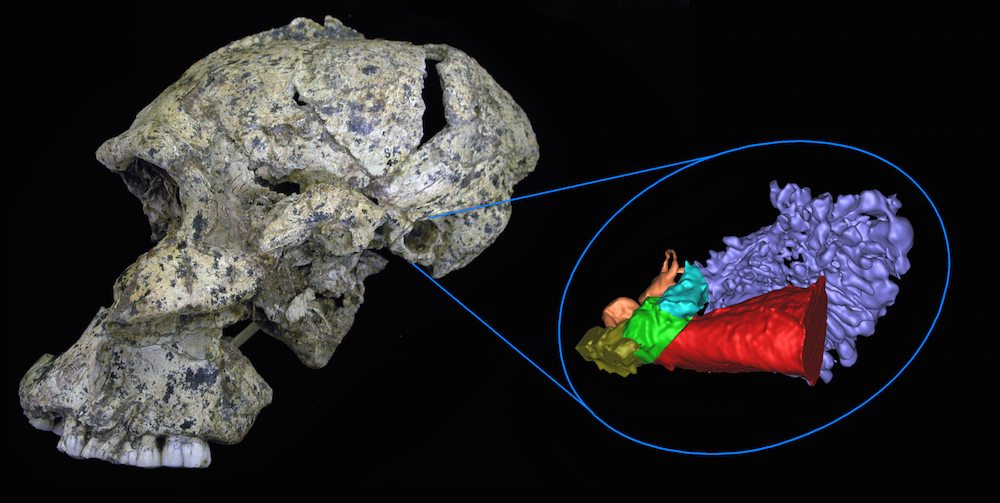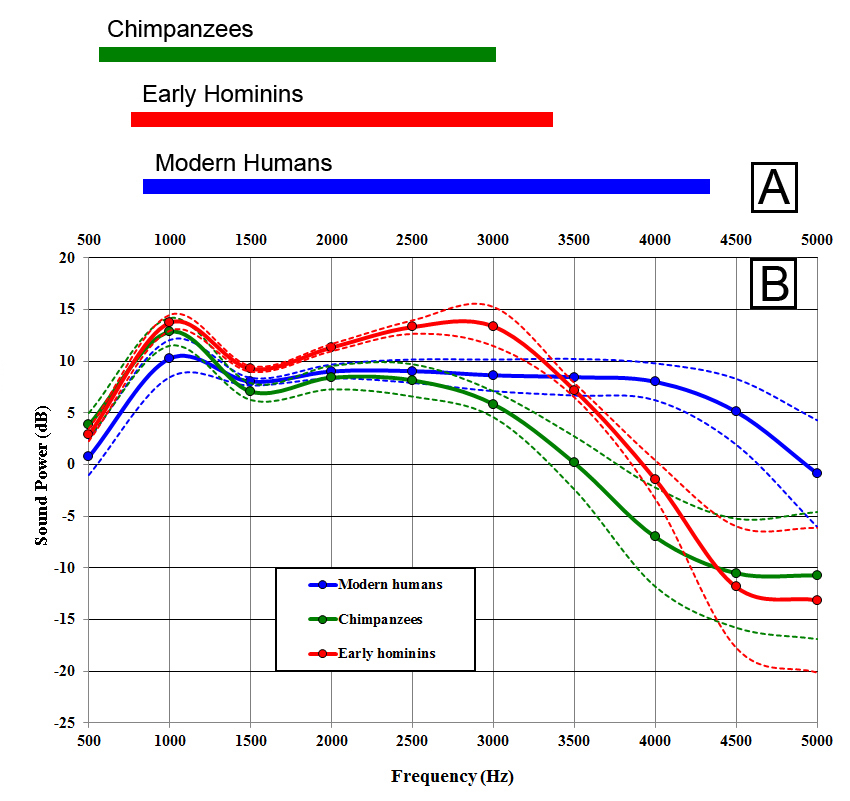All Ears! What Human Ancestors' Hearing Was Like

Human ancestors that lived about 2 million years ago had hearing abilities similar to those of chimpanzees, but their ears had some slight differences that made their hearing more humanlike, a new study finds.
The finding — based on virtual models of early hominin (the ancestors of modern humans), modern chimp and human ears — suggests that, unlike chimps, these now-extinct human ancestors had a remarkable sensitivity to high-frequency sounds. These types of sounds are used in modern-day human communication — including the sounds made by the letters "K," "T," "Th," "F" and "S" — and could have helped hominins detect short-range vocal communication during their time, the researchers said.
The authors suggested that the ability to hear short-range communication would have favored the open savanna, adding evidence that early hominins once lived there. [Gallery: See Images of Our Closest Human Ancestor]
"[The hominins'] hearing pattern is similar to a chimpanzee['s], but slightly different," said lead researcher Rolf Quam, an assistant professor of biological anthropology at Binghamton University in New York. "That difference seems to be in the direction of humans."
Previous studies have examined the differences between human and chimp ear anatomy and auditory abilities, but less is known about the hearing skills of early hominins, Quam said.
To learn more, the researchers traveled to South Africa, where they took computerized tomography (CT) scans of early hominins, including the remains of two Australopithecus africanus individuals and one Paranthropus robustus individual. They also used CT scans from 10 modern humans (Homo sapiens) and 11 chimps (Pan troglodytes) — modern humans' closest living relatives.
The researchers used these scans to make virtual reconstructions of the ears that included soft tissue. However, their models included some guesswork.
Sign up for the Live Science daily newsletter now
Get the world’s most fascinating discoveries delivered straight to your inbox.
Other scientists have measured the "fleshy dimensions" of modern human ears (such as cartilage and skin), largely to gain a better understanding of hearing and to develop better hearing aids, Quam said. But nobody has extensively measured the fleshy parts of chimp ears, and unsurprisingly, these parts have long since decayed in the hominin samples, he said.
So, the researchers used the human data for all of the species. In the end, they based about half of each model on the species' skeletons and half on the human data, Quam said.
Unexpectedly, the chimpanzee model produced accurate results, he said.
"So the model works for chimpanzees — and, therefore, [for] any possible human ancestor, it should also provide reliable results," Quam told Live Science.
High-frequency hearing
Once the models were complete, the researchers ran a series of audio frequencies through them using a computer program.
The scientists already knew that modern humans can hear a wider range of frequencies — usually between 1 and 6 kilohertz (kHz) — than other primates can. This range includes sounds used in spoken language, which chimps and other primates can't hear as easily.
The results suggest that early humans had a greater sensitivity to some high-pitched frequencies than both modern humans and chimps do, the researchers said. This sensitivity is explained by the hominins' differences in anatomy, such as having a slightly shorter and wider external auditory canal (the tube that leads from the outer ear to the inner ear) and a smaller eardrum.

However, the hominins' ears still have small, primitive-looking stapes footplates (a bone in the middle ear that sends pressure waves into the inner ear when it vibrates), the researchers found.
Both early hominin species had a heightened sensitivity to frequencies between 1.5 and 3.5 kilohertz (kHz) compared with modern humans or chimps, they said. [Top 10 Mysteries of the First Humans]
This ability would have helped them with short-range communication — that is, making vocalizations to one another from up to 75 feet (23 meters) away — on the savanna. (These vocalizations would have been harder to hear in the dense jungle, so short-range communication favors the open savanna, Quam said.)
There is other evidence that early hominins likely lived on the savanna: Studies have found that up to half of their diet consisted of plant resources found on the savanna, Quam said.
But Quam stressed that just because the hominins had sharp hearing, and possibly made high-frequency sounds, that doesn't mean that they had a language like modern humans do today.
"They certainly could communicate vocally," Quam said in a statement. "All primates do, but we're not saying they had fully developed human language, which implies a symbolic content."
A word of caution
This isn't Quam's first study on hominin hearing. Previously, he and his colleagues looked at the hearing capabilities of several fossil hominin individuals from Sima de los Huesos (Pit of the Bones) in northern Spain. These 430,000-year-old hominins, thought to be ancestors of the Neanderthals, have hearing abilities that are almost similar to those of modern humans, and unlike the more chimplike hearing of the African hominins studied in the new paper, he said.
However, people should be cautious about interpreting the findings of the study, said Bernard Wood, a professor of human origins at The George Washington University in Washington, D.C., who was not involved with the study.
"I applaud them for trying to do it," he said. "[But] my concern is that there are a whole bunch of assumptions that they have made [about hominin ears]."
It's also unknown whether hearing ability can be linked to what sort of environment the early hominins inhabited, so "one needs to be a little careful about joining these dots," Wood said.
The new study was published online today (Sept. 25) in the journal Science Advances.
Follow Laura Geggel on Twitter @LauraGeggel. Follow Live Science @livescience, Facebook & Google+. Original article on Live Science.

Laura is the archaeology and Life's Little Mysteries editor at Live Science. She also reports on general science, including paleontology. Her work has appeared in The New York Times, Scholastic, Popular Science and Spectrum, a site on autism research. She has won multiple awards from the Society of Professional Journalists and the Washington Newspaper Publishers Association for her reporting at a weekly newspaper near Seattle. Laura holds a bachelor's degree in English literature and psychology from Washington University in St. Louis and a master's degree in science writing from NYU.
Why is yawning contagious?
Scientific consensus shows race is a human invention, not biological reality









